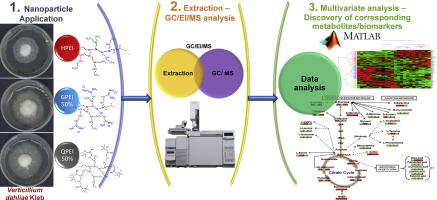当前位置:
X-MOL 学术
›
Pestic. Biochem. Phys.
›
论文详情
Our official English website, www.x-mol.net, welcomes your feedback! (Note: you will need to create a separate account there.)
Metabolomics reveals differential mechanisms of toxicity of hyperbranched poly(ethyleneimine)-derived nanoparticles to the soil-borne fungus Verticillium dahliae Kleb
Pesticide Biochemistry and Physiology ( IF 4.7 ) Pub Date : 2020-05-01 , DOI: 10.1016/j.pestbp.2020.02.001 Maira Lykogianni 1 , Evgenia-Anna Papadopoulou 2 , Andreas Sapalidis 3 , Dimitris Tsiourvas 3 , Zili Sideratou 3 , Konstantinos A Aliferis 4
Pesticide Biochemistry and Physiology ( IF 4.7 ) Pub Date : 2020-05-01 , DOI: 10.1016/j.pestbp.2020.02.001 Maira Lykogianni 1 , Evgenia-Anna Papadopoulou 2 , Andreas Sapalidis 3 , Dimitris Tsiourvas 3 , Zili Sideratou 3 , Konstantinos A Aliferis 4
Affiliation

|
There is a consensus on the urge for the discovery and assessment of alternative, improved sources of bioactivity that could be developed as plant protection products (PPPs), in order to combat issues that the agrochemical sector is facing. Based on the recent advances in nanotechnology, nanoparticles seem to have a great potential towards the development of the next generation nano-PPPs used as active ingredients (a.i.) per se or as nanocarriers in their formulation. Nonetheless, information on their mode(s)-of-action (MoA) and mechanisms of toxicity is yet largely unknown, representing a bottleneck in their further assessment and development. Therefore, we have undertaken the task to assess the fungitoxicity of hyperbranched poly(ethyleneimine) (HPEI), quaternized hyperbranched poly(ethyleneimine) (QPEI), and guanidinylated hyperbranched poly(ethyleneimine) (GPEI) nanoparticles to the soil-born plant pathogenic fungus Verticillium dahliae Kleb, and dissect their effects on its metabolism applying GC/EI/MS metabolomics. Results revealed that functionalization of HPEI nanoparticles with guanidinium end groups (GPEI) increases their toxicity to V. dahliae, while functionalization with quaternary ammonium end groups (QPEI) decreases it. The treatments with the nanoparticles affected the chemical homeostasis of the fungus, altering substantially its amino acid pool, energy production, and fatty acid content, causing additionally oxidative and osmotic stresses. To the best of our knowledge, this is the first report on the comparative toxicity of HPEI, QPEI, and GPEI to filamentous fungi applying metabolomics. The findings could be exploited in the study of the quantitative structure-activity relationship (QSAR) of HPEI-derived nanoparticles and their further development as nano-PPPs.
中文翻译:

代谢组学揭示了超支化聚(乙烯亚胺)衍生的纳米粒子对土壤传播真菌大丽轮枝菌的不同毒性机制
对于发现和评估可作为植物保护产品 (PPP) 开发的替代性改进生物活性来源的迫切需求,已达成共识,以解决农化行业面临的问题。基于纳米技术的最新进展,纳米粒子似乎在开发下一代纳米 PPP 方面具有巨大潜力,它们本身用作活性成分 (ai) 或在其配方中用作纳米载体。尽管如此,关于它们的作用模式 (MoA) 和毒性机制的信息在很大程度上仍是未知的,这代表了它们进一步评估和开发的瓶颈。因此,我们承担了评估超支化聚(乙烯亚胺)(HPEI)、季铵化超支化聚(乙烯亚胺)(QPEI)、和胍基化超支化聚(乙烯亚胺)(GPEI)纳米粒子到土壤中的植物病原真菌 Verticillium dahliae Kleb,并应用 GC/EI/MS 代谢组学分析它们对其代谢的影响。结果表明,HPEI 纳米颗粒与胍端基 (GPEI) 的功能化增加了它们对大丽花的毒性,而季铵端基 (QPEI) 的功能化降低了毒性。纳米颗粒的处理影响了真菌的化学稳态,显着改变了其氨基酸库、能量产生和脂肪酸含量,导致额外的氧化和渗透压力。据我们所知,这是第一次应用代谢组学研究 HPEI、QPEI 和 GPEI 对丝状真菌的毒性比较。
更新日期:2020-05-01
中文翻译:

代谢组学揭示了超支化聚(乙烯亚胺)衍生的纳米粒子对土壤传播真菌大丽轮枝菌的不同毒性机制
对于发现和评估可作为植物保护产品 (PPP) 开发的替代性改进生物活性来源的迫切需求,已达成共识,以解决农化行业面临的问题。基于纳米技术的最新进展,纳米粒子似乎在开发下一代纳米 PPP 方面具有巨大潜力,它们本身用作活性成分 (ai) 或在其配方中用作纳米载体。尽管如此,关于它们的作用模式 (MoA) 和毒性机制的信息在很大程度上仍是未知的,这代表了它们进一步评估和开发的瓶颈。因此,我们承担了评估超支化聚(乙烯亚胺)(HPEI)、季铵化超支化聚(乙烯亚胺)(QPEI)、和胍基化超支化聚(乙烯亚胺)(GPEI)纳米粒子到土壤中的植物病原真菌 Verticillium dahliae Kleb,并应用 GC/EI/MS 代谢组学分析它们对其代谢的影响。结果表明,HPEI 纳米颗粒与胍端基 (GPEI) 的功能化增加了它们对大丽花的毒性,而季铵端基 (QPEI) 的功能化降低了毒性。纳米颗粒的处理影响了真菌的化学稳态,显着改变了其氨基酸库、能量产生和脂肪酸含量,导致额外的氧化和渗透压力。据我们所知,这是第一次应用代谢组学研究 HPEI、QPEI 和 GPEI 对丝状真菌的毒性比较。



























 京公网安备 11010802027423号
京公网安备 11010802027423号